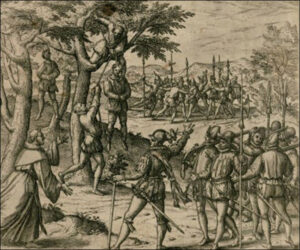By the summer of 1495, Queen Isabella and King Ferdinand had grown sufficiently concerned with Fray Buil’s, Pedro Margarite’s, and others’ criticisms of Columbus’s governance and the failure of gold shipments home to appoint an investigator to review his conduct and fitness. They selected as investigator Juan Aguado, a royal provisioner who’d sailed on the second voyage, and Aguado departed for “Española” on August 5, 1495 (528 years ago).
The sovereigns were focused on Columbus’s treatment of Spaniards, not “Indians.” Aguado carried their orders directing Columbus to dispatch a few identified Spaniards he’d treated harshly back to Spain and, more broadly, to not withhold food from Spaniards, addressing the charge that he’d so punished his critics.
As depicted in Columbus and Caonabó, Aguado shared Buil and Margarite’s disdain for Columbus and spent weeks in Isabela interrogating witnesses, deluged with Spaniards’ criticisms of Columbus. He also visited Magua and gave Chief Manicoatex (Caonabó’s younger brother, the Taíno leader in the battle of Santo Cerro, see post of March 27) and other caciques hope that Columbus would be replaced by a successor instructed to treat the Indians better.
Regardless, when Aguado and Columbus returned to Spain in 1496, Columbus would retain Isabella and Ferdinand’s confidence and secure their authorization for his third voyage.
The engraving (included in Columbus and Caonabó) portrays Columbus’s punishment of Spaniards, taken from Theodor de Bry, 1594, courtesy of the John Carter Brown Library, portion of rec. no. 09887-9. Many believe the friar to the left is Fray Buil.
One of the identified Spaniards Columbus had treated harshly was a nobleman, Don Fernando de Guevara. Guevara did return to Spain for three years, but in 1499 he would come back to Española and reside briefly in Behecchio and Anacaona’s Xaraguá, as will be depicted in the next sequel.

